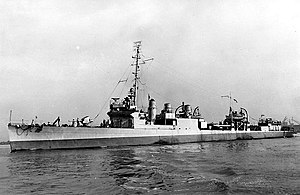USS Blakeley
 USS Blakeley in September 1942, after modernization
| |
| History | |
|---|---|
| Name | Blakeley |
| Namesake | Johnston Blakeley |
| Builder | William Cramp & Sons, Philadelphia |
| Cost | $1,448,367.50 (hull & machinery)[1] |
| Yard number | 465 |
| Laid down | 26 March 1918 |
| Launched | 19 September 1918 |
| Commissioned | 8 May 1919 |
| Decommissioned | 29 June 1922 |
| Recommissioned | 1932 |
| Decommissioned | 1937 |
| Recommissioned | 16 October 1939 |
| Decommissioned | 21 July 1945 |
| Stricken | 13 August 1945 |
| Fate | Sold for scrapping 30 November 1945 |
| General characteristics | |
| Class and type | Wickes-class destroyer |
| Displacement | 1,154 tons |
| Length | 314 ft 5 in (95.8 m) |
| Beam | 31 ft 8 in (9.7 m) |
| Draft | 9 ft 0 in (2.7 m) |
| Speed | 35 knots (65 km/h) |
| Complement | 122 officers and enlisted |
| Armament |
|
The second USS Blakeley (DD–150) was a Wickes-class destroyer in the United States Navy, named for Captain Johnston Blakeley.
Built in 1918, she saw patrol duty along the
Design and construction
Blakeley was one of 111 Wickes-class destroyers built by the United States Navy between 1917 and 1919. She, along with 20 of her sisters, were constructed at William Cramp & Sons shipyards in Philadelphia using specifications and detail designs drawn up by Bath Iron Works.[2][3]
She had a
Specifics on Blakeley's performance are not known, but she was one of the group of Wickes-class destroyers known unofficially as the 'Liberty Type' to differentiate them from the destroyers constructed from detail designs drawn up by Bethlehem Steel, which used Parsons or Westinghouse turbines. The 'Liberty' type destroyers deteriorated badly in service, and in 1929 all 60 of this group were retired by the Navy. Actual performance of these ships was far below intended specifications especially in fuel economy, with most only able to make 2,300 nautical miles (4,260 km) at 15 knots (28 km/h) instead of the design standard of 3,100 nautical miles (5,741 km) at 20 knots (37 km/h).[2][5] The class also suffered problems with turning and weight.[6]
Blakeley was launched on 19 September 1918 by William Cramp & Sons Ship and Engine Building Company in Philadelphia and sponsored by the wife of Charles Adams Blakeley. The ship was commissioned on 8 May 1919. She was the second ship to be named for Johnston Blakeley, the first was a torpedo boat commissioned in 1904. A subsequent USS Blakely would be commissioned, this one a Knox-class frigate. This third ship would also be named for Charles Adams Blakely.[4]
History
Upon commissioning, Blakeley immediately joined the
Blakeley was again commissioned on 16 October 1939. She then joined the

On 25 May 1942, Blakeley was on a patrol off
At Fort-de-France, she was fitted with a wooden
Blakeley spent most of the rest of the war on convoy escort duty in the
Following this duty, Blakeley was decommissioned at Philadelphia Naval Yard on 21 July 1945 and sold for
References
Notes
- ^ "Table 21 - Ships on Navy List June 30, 1919". Congressional Serial Set. U.S. Government Printing Office: 762. 1921.
- ^ a b c Gardiner & Gray 1985, p. 124.
- ^ Friedman 2003, p. 40.
- ^ a b c d e f g DANFS 1991, p. 301.
- ^ Friedman 2003, p. 41.
- ^ Friedman 2003, p. 46.
- ^ Bonner 1996, p. 10.
- ^ a b Marley 2008, p. 1013.
- ^ a b c d Bonner 1996, p. 11.
- ^ Friedman 2003, p. 62.
Sources
 This article incorporates text from the public domain Dictionary of American Naval Fighting Ships. The entry can be found here.
This article incorporates text from the public domain Dictionary of American Naval Fighting Ships. The entry can be found here.- Bonner, Kermit H. (1996), Final Voyages, ISBN 978-1-56311-289-8
- Dictionary of American naval fighting ships / Vol.1, Historical sketches : letters A through B, OCLC 551573855
- Friedman, Norman (2003), United States Destroyers: An Illustrated Design History, ISBN 978-1-55750-442-5
- Gardiner, Robert; Gray, Randal (1985), Conway's All the World's Fighting Ships 1906–1921, Volume 2, ISBN 978-0-87021-907-8
- Marley, David (2008), Wars of the Americas: A Chronology of Armed Conflict in the Western Hemisphere, ISBN 978-1-59884-100-8
